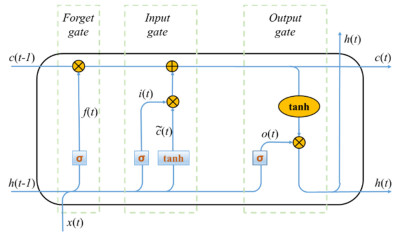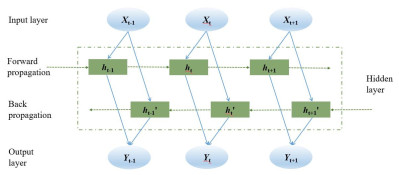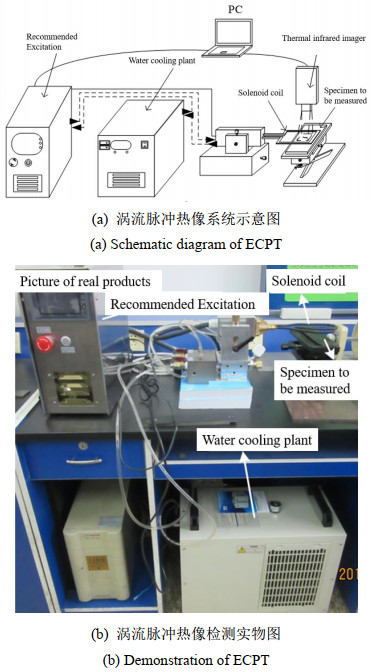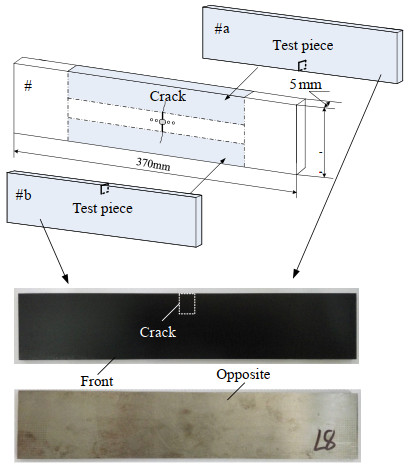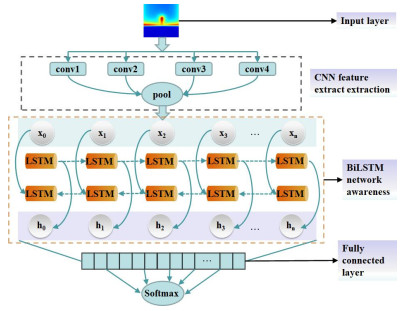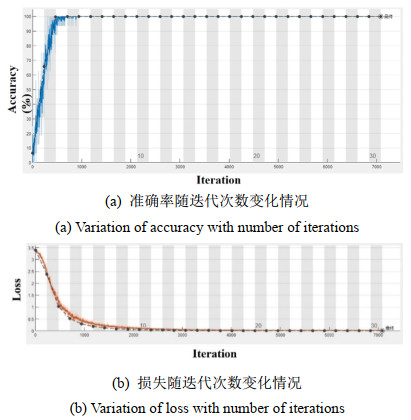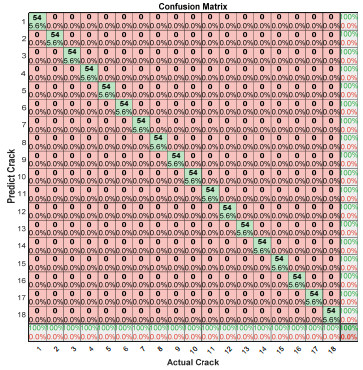Detection and Recognition of Metal Fatigue Cracks by Bi-LSTM Based on Eddy Current Pulsed Thermography
-
摘要: 涡流脉冲热像(Eddy current pulsed thermography,ECPT)技术是一种新型的无损检测方法,广泛应用于金属材料结构的检测,但该技术常依赖人工经验提取特征进行裂纹检测与识别,自动化和智能性化程度不足。结合涡流脉冲热像技术以及循环神经网络(Recurrent Neural Network,RNN)的特性,提出一种基于双向长短期记忆网络(Bidirectional Long Short-Term Memory Network,Bi-LSTM)金属疲劳裂纹涡流脉冲热像分类识别方法。实验通过涡流加热装置对被测金属试件进行感应加热,使用红外热像采集装置对金属平板试件进行实时的数据采集,获得图像序列并制作数据集。运用设计的Bi-LSTM模型增强特征向量中的时序信息,对不同尺寸裂纹的热图像进行训练并测试。实验分析表明,Bi-LSTM网络可有效应用于金属疲劳裂纹检测与识别,针对现有裂纹检测准确率可达到100%,优于传统神经网络和其他深度学习的模型,具有更高的识别精度。Abstract: Eddy current pulsed thermography is a new nondestructive testing method that is widely used in metal structure testing. However, the extraction of features for crack detection and identification relies on manual experience, and the degree of automation and intelligence is insufficient. By combining the characteristics of eddy current pulsed thermography with a recurrent neural network (RNN), a bidirectional long short-term memory (Bi-LSTM)-based eddy current pulse thermography method is proposed for metal fatigue crack classification and recognition. The Bi-LSTM model was designed to enhance the transient information in the feature vectors. In the experiments, an eddy current heating device was used to heat the tested metal specimens. A real-time dataset was created using an infrared thermal camera that collected sequences of images. The Bi-LSTM model was trained on thermal images of cracks of different sizes and tested. Experimental analyses show that the Bi-LSTM network can be effectively applied for metal fatigue crack detection and recognition, with the detection accuracy reaching 100% for the cracks used in the experiments, which is superior to that of traditional neural networks and other deep learning models.
-
0. 引言
红外成像具有非接触直接测量输变电设备状态的特征,无需停电,在电力领域具有广泛的应用[1-3]。输变电设备在野外严峻环境中长期运行,由于材料老化、污秽闪络、机械受损等因素,常伴随有局部放电、温度增高等现象。绝缘子作为输电线路重要部件,起到电气隔离和机械支撑的作用,当红外图像显示的温度较高,表明其有异常缺陷,这是因为场强不均匀发生局部放电,严重时可能导致线路故障,甚至造成停电故障。文献[4-5]开展了变压器高压套管的红外诊断研究,通过热像特征谱图分析了故障原因。红外图像可应用于交流滤波器的故障分析中,提取其跳闸的典型故障特征[6-8]。
输变电设备红外图谱特征提取主要为图像处理方法,诸如纹理、色彩、边框等图像特征[9-10]。随着无人机航拍技术的发展,输变电设备红外图谱呈现爆发式增长,深度学习提供了一种良好的手段[11-13],采用卷积神经网络(Convolutional Neural Networks,CNN)的方法,对海量图片进行训练学习,提取特征进行测试和验证。CNN通过卷积层计算,输入较深层的特征图,对于小目标绝缘子、套管,权重值相对较少,无法实现小目标的有效提取[14-15]。针对这一缺点,本文对Faster R-CNN方法进行改进,提高绝缘子红外图谱诊断的精度。
1. 改进的Faster R-CNN方法
1.1 Faster R-CNN原理
区别于普通的CNN,Faster R-CNN增加了一个区域提取网络(Region Proposal Network,RPN),即图 1中的候选区域,摒弃传统的滑动窗口,可在GPU直接运行计算,极大地加快了计算速度。RPN判断每个像素点对应的多个不同尺度和宽高比的锚框是否为前景目标的二分类,形成候选区域。
Faster R-CNN一般采用随机梯度下降法(Stochastic Gradient Descent,SGD)训练神经网络,见式(1):
$$ h(x) = \sum\limits_{i = 0}^n {{w_i}} {x_i} = {\mathit{\boldsymbol{W}}^{\rm{T}}}\mathit{\boldsymbol{X}} $$ (1) 式中:X为输入;W为权重;wi、xi分别表示第i个权重和输入;h(x)为对应的输出。
损失函数S(W)基于平方误差实现,见式(2):
$$ S(\mathit{\boldsymbol{W}}) = \frac{1}{2}\sum\limits_{i = 0}^m {{{({h_W}({x_i}) - {y_i})}^2}} $$ (2) 式中:yi为真实输出。
W的更新函数见式(3):
$$ {W_j} = {W_j} - \alpha \frac{\partial }{{\partial {W_j}}}S(\mathit{\boldsymbol{W}}) $$ (3) 式中:α为学习率,可设置步长。W通过梯度下降法进行求解,首先正向计算样本输出值,接着根据反向传递的误差迭代计算,常用在CNN训练中。
RPN的选择本质是通过平移或者尺度变化的方法将合适的区域提取网络R变成$\hat C$,从而接近实际的候选框C:
$$ f({R_x}, {R_y}, {R_w}, {R_h}) = \left( {{{\hat C}_x}, {{\hat C}_y}, {{\hat C}_w}, {{\hat C}_h}} \right) \approx \left( {{C_x}, {C_y}, {C_w}, {C_h}} \right) $$ (4) 式中:(x, y)、(w, h)分别为矩形区域的中心坐标和宽、高。
令${t_*}$为矩形区域的平移和缩放量,则有:
$$ \left\{ {\begin{array}{*{20}{l}} {{t_x} = ({C_x} - {R_x})/{R_{\rm{w}}}}\\ {{t_y} = ({C_y} - {R_y})/{R_{\rm{h}}}}\\ {{t_{\rm{w}}} = \lg ({C_{\rm{w}}}/{R_{\rm{w}}})}\\ {{t_{\rm{h}}} = \lg ({C_{\rm{h}}}/{R_{\rm{h}}})} \end{array}} \right. $$ (5) 式中:tx、ty为矩形区域的中心坐标平移量;tw、th分别为矩形区域的宽、高的缩放量。
预测值计算过程为:
$$ {d_*}(R) = w_*^{\rm{T}}\phi (R) $$ (6) 式中:ϕ是最后一次卷积计算。
损失函数的目标值计算见式(7),通过调整平移和缩放的尺度,确定最终的候选区域[16]:
$$ {L_{{\rm{oss}}}} = \sum\limits_{i = 1}^N {{{(t_*^i - w_*^{\rm{T}}\phi ({C^i}))}^2}} $$ (7) 1.2 压缩激励结构
为了增强Faster R-CNN的小目标特征提取能力,引入压缩激励结构,即压缩和激励两大操作,设图像的特征参数设置为(H, W, K),分别表示为长、宽和通道数。
压缩操作Fsq(·)基于各个通道实现特征图空间信息的压缩,见式(8):
$$ {h_c} = {F_{{\rm{sq}}}}\left( {{k_c}} \right) = \frac{1}{{H \times W}}\sum\limits_{i = 1}^H {\sum\limits_{j = 1}^W {{k_c}(i, j)} } $$ (8) 式中:kc表示第c个通道;hc表示经过压缩后输出向量h的第c个元素。
激励操作分为激励Fex(·)和校准Fscale(·)两个过程,分别见式(9)和式(10):
$$ s = {F_{{\rm{ex}}}}(h, w) = \sigma (g(z, w)) = \sigma ({w_2}\delta ({w_1}z)) $$ (9) 式中:σ是sigmoid激活函数;w1为$\frac{c}{r} \times \vec C$的实数矩阵,表示通道的缩减,r为缩减因子;δ是ReLU激活函数,w2为$\vec C \times \frac{c}{r}$的实数矩阵,表示通道的恢复。
$$ {\tilde h_c} = {F_{{\rm{scale}}}}({h_c}, {s_c}) = {s_c}.{h_c} $$ (10) 式中:sc表示激活向量s的第c个元素;${\tilde h_c}$表示校准后的对应元素。
2. 绝缘子红外图像的深度学习
2.1 环境搭建
本文基于改进的Faster R-CNN方法,对平台的环境搭建要求较高,具体配置见表 1。操作系统为开源Linux,数据库为MySQL;硬件配置较高,CPU采用Intel高端系列,内存和硬盘容量均较大,保证大量数据的高效运算。框架采用2018年初公开的目标检测平台Detectron,包含最具代表性的目标检测、图像分割、关键点检测算法。
表 1 软硬件配置Table 1. Hardware and software configurationName Model Operating system Ubuntu 16.04.1 Database mysql 5.5.20 CPU Intel Xeon Silver 4114T 12C GPU NVIDIA GTX1080Ti Memory 32 G Hard disk 1 T Frame Detectron 2.2 数据准备
图像数据来源于多条输电线路无人机拍摄的大量绝缘子照片。在神经网络的训练过程中,对正负样本的判定见图 2,主要基于锚框映射图与真实目标框的交并比(Intersection over Union,IoU)来进行计算分类。首先对RPN形成的锚框进行排序筛选形成锚框序列,接着利用边框回归参数向量修正锚框的位置形成候选区域集合,然后计算所有感兴趣区域(Region of Interest,RoI)与真实目标框的IoU,求最大值,并判断其是否大于0.5,若满足,则为正样本,否则为负样本。
完成正负样本的判定后,为了使样本的采样尽量均衡,保证双方的训练集和验证集数量一致,同时采用迁移学习的方法,经过相关修正与补偿,扩充样本总量至2375,样本信息配置见表 2。
表 2 样本配置信息Table 2. Information of sample configurationsample type training set verification set test set total positive 500 250 750 1500 negative 500 250 125 875 total 1000 500 875 2375 2.3 改进模型的建立
普通的CNN方法,原始图像经过卷积层和池化层后,全链接层输出结果,本文方法的结构如图 3所示,引入压缩激励的过程,压缩特征图的空间信息,并通过激励操作学习通道间的依赖关系,可自适应分配每个通道的权重值,提取有利于任务的重要特征通道,最终能进一步增强网络模型的特征提取能力,采用SE-DenseNet-169框架的Faster R-CNN模型。
改进模型主要完成绝缘子异常状态的精准识别,首先对红外原始图像进行相关修正与补偿实现样本扩充,然后采用本文方法进行训练,收敛后,获得最终的改进Faster R-CNN模型。
3. 实验分析
3.1 精确度衡量
CNN学习中,精确度的衡量一般会采用准确率(Precision)和召回率(Recall),其计算过程分别见式(11)和式(12):
$$ {P_{{\rm{re}}}} = \frac{{{\rm{TP}}}}{{{\rm{TP}} + {\rm{FP}}}} $$ (11) $$ {P_{{\rm{ca}}}} = \frac{{{\rm{TP}}}}{{{\rm{TP + FN}}}} $$ (12) 式中:TP表示是实际值和预测值均是异常绝缘子的个数;FP表示预测值是异常绝缘子,实际值却不是的个数;FN表示是实际值是异常绝缘子,预测值却不是的个数。
为进一步衡量改进模型的优劣,这里采用平均检测精度(mean Average Precision,mAP),其中AP等价于召回率和准确率形成曲线与横轴包围的几何图形的面积,对所有类别的AP求平均值即可得到mAP。
3.2 不同方法的对比研究
基于样本数据,开展BP、Faster R-CNN以及本文方法的精确度和效率对比研究,不同方法的实验结果统计见表 3。Faster R-CNN和本文方法在Precision方面均明显优于BP方法,本文方法的Recall最高,mAP也最高,相对于BP提高了近10%,这说明经过改进的Faster R-CNN对于小目标的特征提取具有明显的优势。本文方法通过压缩激励结果,减少了数据量的计算,所以相对于其他方法,有更高的效率。
表 3 不同方法的实验结果统计Table 3. Statistics of experimental results by different methodsName Precision Recall mAP Time/s BP 93.5% 90.4% 80.3% 2.3 Faster R-CNN 98.7% 95.3% 88.7% 1.2 BFEM 99.2% 97.6% 90.2% 0.9 绘制其准确率-召回率关系曲线,如图 4所示,可更加形象直观地反映出本文方法对绝缘子异常特征的提取优势,因为另外两种方法的曲线均被完整的覆盖,说明本文方法改进效果明显。
3.3 不同类型绝缘子对比研究
常见绝缘子排列有单Ⅰ型、双Ⅰ型以及Ⅴ型。本文开展这3类绝缘子的红外图像研究,比较不同排列方式的诊断准确率,如图 5所示。根据电力标准DL/T 664-2008[19],图(b)和图(c)绝缘子端部明显发热,属于异常情况。
不同类型绝缘子的异常诊断准确率见表 4,准确率均较高,均在90%以上;Ⅰ型和Ⅴ型绝缘子的准确率明显优于双Ⅰ型绝缘子,这是因为双Ⅰ型绝缘子会出现两排绝缘子重叠的情况,对红外图像的研究造成一定的影响,为此无人机对于该种类型绝缘子的线路需开展多种角度的拍摄。
表 4 绝缘子异常诊断的准确率Table 4. Accuracy of insulator anomaly diagnosisInsulator type Abnormal total Detected number Accuracy Single Ⅰ 62 61 98.4% Double Ⅰ 47 44 93.6% Ⅴ 31 31 100.0% 4. 结论
本文提出一种改进的Faster R-CNN方法,引入激励压缩环节,搭建训练模型,完成绝缘子红外图像的异常诊断,并成功应用于电力现场运维。本文方法可高效并精准地识别出绝缘子的异常缺陷,mAP达到90.2%。研究结果可为输电线路绝缘子缺陷识别研究提供一定的参考。
-
表 1 18类金属试件裂纹长度及其编号
Table 1 Crack length and numbering of 18 metal specimens
Serial numbers Crack length/μm 1 0 2 1707.41 3 1986.66 4 2181.48 5 3454.42 6 3474.50 7 3898.49 8 4639.50 9 4866.00 10 5263.50 11 5374.71 12 5477.50 13 5624.33 14 6559.11 15 6570.00 16 6577.41 17 6629.00 18 6740.50 表 2 本文设计的模型各网络层具体参数
Table 2 Specific parameters of each network layer in this paper
Layer Detailed parameters Input 256×256,Thermal image Conv1 Number and size of convolution kernels,2
5×5×1Conv2 Number and size of convolution kernels,4
5×5×1Conv3 Number and size of convolution kernels,8
5×5×1Conv4 Number and size of convolution kernels,16
5×5×1Pool Number and size of convolution kernels,1
2×2×1Drop Dropout (0.2) FC 128 fully connected layer Bi-LSTM1 Number of hidden layer nodes 64 Bi-LSTM2 Number of hidden layer nodes 32 Softmax Softmax 表 3 不同批量尺寸识别准确率
Table 3 Different batch size identification accuracy
Batch size Accuracy/% Time/s 16 98.77 261 32 99.87 220 64 100 197 128 94.78 162 表 4 复合检测条件下裂纹尺寸及其标签
Table 4 Crack size and label under composite detection conditions
Serial number Crack length/μm Serial number Crack length/μm a 5374.71 f 7507.79 b 5624.33 g 7930 c 6559.11 h 8414.54 d 6577.41 i 9143 e 7275 j 9453 表 5 Bi-LSTM与其他算法的实验对比
Table 5 Experimental comparison between BI-LSTM and other algorithms
Model Bi-LSTM (This paper) SVM KNN GooLeNet VGG ResNet Accuracy% 100 96.7 99.59 97.8 98.6 99.3 Recognition time/s 197 462 293 309 345 322 -
[1] 韩丽民. 采煤机关键部件故障分析与诊断[J]. 能源与节能, 2021(11): 156-157, 159. DOI: 10.16643/j.cnki.14-1360/td.2021.11.061. HAN limin. Fault analysis and diagnosis of key parts of shearer[J]. Energy and Conservation, 2021(11): 156-157, 159. DOI: 10.16643/j.cnki.14-1360/td.2021.11.061
[2] 窦建. 机电设备维修管理的现状和对策认识实践[J]. 中国设备工程, 2022(13): 79-81. https://www.cnki.com.cn/Article/CJFDTOTAL-SBGL202213036.htm DOU Jian. Current situation and countermeasures of maintenance management of mechanical and electrical equipment[J]. China Equipment Engineering, 2022(13): 79-81. https://www.cnki.com.cn/Article/CJFDTOTAL-SBGL202213036.htm
[3] 冯辅周, 朱俊臻, 闵庆旭, 等. 涡流热像无损检测技术综述[J]. 装甲兵工程学院学报, 2016, 30(6): 60-67. https://www.cnki.com.cn/Article/CJFDTOTAL-ZJBX201606012.htm FENG Fuzhou, ZHU Junzhen, MIN Qingxu, et al. Review of eddy current thermography nondestructive testing[J]. Journal of Academy of Armored Force Engineering, 2016, 30(6): 60-67. https://www.cnki.com.cn/Article/CJFDTOTAL-ZJBX201606012.htm
[4] 苗玲, 高斌, 石永生, 等. 基于电涡流热成像的钢轨滚动接触疲劳裂纹动态检测研究[J]. 机械工程学报, 2021, 57(18): 86-97. https://www.cnki.com.cn/Article/CJFDTOTAL-JXXB202118011.htm MIAO Ling, GAO Bin, SHI Yongsheng, et al. Dynamic detection of rolling contact fatigue cracks in rail based on eddy current thermal imaging[J]. Journal of Mechanical Engineering, 2021, 57(18): 86-97. https://www.cnki.com.cn/Article/CJFDTOTAL-JXXB202118011.htm
[5] 毕野, 熊新, 叶波, 等. 基于深度学习的涡流热成像技术在无损检测中的应用[J]. 化工自动化及仪表, 2019, 46(9): 690-696. https://www.cnki.com.cn/Article/CJFDTOTAL-HGZD201909002.htm BI Ye, XIONG Xin, YE Bo, et al. Application of eddy current thermal imaging technology based on deep learning in nondestructive testing[J]. Chemical Automation and Instrumentation, 2019, 46(9): 690-696. https://www.cnki.com.cn/Article/CJFDTOTAL-HGZD201909002.htm
[6] GAO B, LI X, WOO W L, et al. Quantitative validation of eddy current stimulated thermal features on surface crack[J]. Ndt & E International, 2017, 85: 1-12.
[7] 孙吉伟, 孙浩, 谢敏, 等. 涡流脉冲热像技术中基于神经网络的检出/漏检预测研究[J]. 红外技术, 2020, 42(8): 795-800. http://hwjs.nvir.cn/article/id/hwjs202008015 SUN Jiwei, SUN Hao, XIE Min, et al. Prediction of detection detection based on neural network in eddy current pulse thermography[J]. Infrared Technology, 2020, 42(8): 795-800. http://hwjs.nvir.cn/article/id/hwjs202008015
[8] 刘建伟, 宋志妍. 循环神经网络研究综述[J]. 控制与决策, 2022, 37(11): 16. https://www.cnki.com.cn/Article/CJFDTOTAL-KZYC202211001.htm LIU Wei, SONG Zhiyan. Review of recurrent Neural networks[J]. Control and Decision Making, 2022, 37(11): 16. https://www.cnki.com.cn/Article/CJFDTOTAL-KZYC202211001.htm
[9] YU Y, SI X, HU C, et al. A review of recurrent neural networks: LSTM cells and network architectures[J]. Neural Computation, 2019, 31(7): 1235-1270.
[10] Crisóstomo de Castro Filho H, Abílio de Carvalho Júnior O, Ferreira de Carvalho O L, et al. Rice crop detection using LSTM, Bi-LSTM, and machine learning models from sentinel-1 time series[J]. Remote Sensing, 2020, 12(16): 2655.
[11] TIAN G, WANG Q, ZHAO Y, et al. Smart contract classification with a bi-LSTM based approach[J]. IEEE Access, 2020, 8: 43806-43816.
[12] 高玉才, 付忠广, 王诗云, 等. 基于Bi-LSTM和自注意力机制的旋转机械故障诊断方法研究[J]. 中国工程机械学报, 2022, 20(3): 273-278. https://www.cnki.com.cn/Article/CJFDTOTAL-GCHE202203017.htm GAO Yucai, FU Zhongguang, WANG Shiyun. Research on fault diagnosis method of rotating machinery based on BI-LSTM and self-attention mechanism[J]. Chinese Journal of Construction Machinery, 2022, 20(3): 273-278. https://www.cnki.com.cn/Article/CJFDTOTAL-GCHE202203017.htm
[13] 温惠英, 张东冉, 陆思园. GA-LSTM模型在高速公路交通流预测中的应用[J]. 哈尔滨工业大学学报, 2019, 51(9): 81-87, 95. https://www.cnki.com.cn/Article/CJFDTOTAL-HEBX201909012.htm WEN Huiying, ZHANG Dongran, LU Siyuan. Application of GA-LSTM model in expressway traffic flow prediction[J]. Journal of Harbin Institute of Technology, 2019, 51(9): 81-87, 95. https://www.cnki.com.cn/Article/CJFDTOTAL-HEBX201909012.htm
[14] MIN Q, ZHU J, SUN J, et al. Investigation of heat source reconstruction of thickness-through fatigue crack using lock-in vibrothermography[J]. Infrared Physics & Technology, 2018, 94: 291-298.
[15] 林丽, 刘新, 朱俊臻, 等. 基于CNN的金属疲劳裂纹超声红外热像检测与识别方法研究[J]. 红外与激光工程, 2022, 51(3): 475-483. https://www.cnki.com.cn/Article/CJFDTOTAL-HWYJ202203042.htm LIN Li, LIU Xin, ZU Junzhen, et al. Research on detection and identification of metal fatigue crack by ultrasonic infrared thermography based on CNN[J]. Infrared and Laser Engineering, 2022, 51(3): 475-483. https://www.cnki.com.cn/Article/CJFDTOTAL-HWYJ202203042.htm
[16] 纪盟盟, 肖金壮, 李瑞鹏. CNN联合BI-LSTM混合模型的手势识别算法[J]. 激光杂志, 2021, 42(6): 88-91. https://www.cnki.com.cn/Article/CJFDTOTAL-JGZZ202106019.htm JI Mengmeng, XIAO Jinzhuang, LI Ruipeng. Gesture recognition algorithm based on CNN combined with BI-LSTM hybrid model[J]. Laser Magazine, 2021, 42(6): 88-91. https://www.cnki.com.cn/Article/CJFDTOTAL-JGZZ202106019.htm
[17] 于洋, 马军, 王晓东, 等. 融合深度可分离小卷积核和CBAM的改进CNN故障诊断模型[J]. 电子测量技术, 2022, 45(6): 171-178. https://www.cnki.com.cn/Article/CJFDTOTAL-DZCL202206027.htm YU Yang, MA Jun, WANG Xiaodong, et al. Improved CNN fault diagnosis model by fusing deep separable small convolution kernel and CBAM[J]. Electronic Measurement Technique, 2022, 45(6): 171-178. https://www.cnki.com.cn/Article/CJFDTOTAL-DZCL202206027.htm
[18] GAO Hongbin, ZHANG Ya, LV Wenkai, et al. A deep convolutional generative adversarial networks-based method for defect detection in small sample industrial parts images[J]. Applied Sciences, 2022, 12(13): 6569.
[19] JIAO J, ZHAO M, LIN J, et al. A multivariate encoder information based convolutional neural network for intelligent fault diagnosis of planetary gearboxes[J]. Knowledge-Based Systems, 2018, 160: 237-250.
[20] 刘杰, 丁武学, 孙宇, 等. 基于SVM的搅拌摩擦焊表面缺陷分类[J]. 组合机床与自动化加工技术, 2022(3): 130-133, 137. https://www.cnki.com.cn/Article/CJFDTOTAL-ZHJC202203031.htm LIU Jie, DING Xuewu, SUN Yu, et al. Surface defect classification of friction stir welding based on SVM[J]. Modular Machine Tools and Automatic Processing Technology. 2022(3): 130-133, 137. https://www.cnki.com.cn/Article/CJFDTOTAL-ZHJC202203031.htm
[21] GUO J, WANG X. Image classification based on SURF and KNN[C]//IEEE/ACIS 18th International Conference on Computer and Information Science (ICIS), 2019: 356-359.
[22] MA J, RAO J, QIAO Y, et al. Sprouting potato recognition based on deep neural network GoogLeNet[C]//IEEE 3rd International Conference on Cloud Computing and Internet of Things (CCIOT), 2018: 502-505.
[23] DUAN C, YIN P, ZHI Y, et al. Image classification of fashion-MNIST data set based on VGG network[C]//Proceedings of 2019 2nd International Conference on Information Science and Electronic Technology (ISET). International Informatization and Engineering Associations: Computer Science and Electronic Technology International Society, 2019: 19.
[24] Mahajan A, Chaudhary S. Categorical image classification based on representational deep network (RESNET)[C]//2019 3rd International conference on Electronics, Communication and Aerospace Technology (ICECA), 2019: 327-330.
-
期刊类型引用(6)
1. 刘传洋,吴一全. 基于红外图像的电力设备识别及发热故障诊断方法研究进展. 中国电机工程学报. 2025(06): 2171-2196 .  百度学术
百度学术
2. 邱刚,高超,陈杰,谭笑,杨景刚,李鸿泽. 基于热成像技术的支柱瓷绝缘子实时故障诊断研究. 绝缘材料. 2023(06): 100-105 .  百度学术
百度学术
3. 张玲玲,张继冉,许廒,任攀攀,丁立斌. 基于红外图像处理的建筑外窗缺陷能耗分析研究. 红外技术. 2023(09): 996-1004 .  本站查看
本站查看
4. 尹林,胡京,王文彬,贺林轩,周恺,苏朝辉,闫磊,刘若溪,王博,屠幼萍. 环境条件对基于无人机红外检测的零值绝缘子检测判据的影响研究. 电瓷避雷器. 2023(05): 171-177 .  百度学术
百度学术
5. 刘新伯,李昊,陈强,梁鉴如,郭梦茹. 复杂背景下多个绝缘子串红外图像分割方法. 计算技术与自动化. 2022(02): 125-130 .  百度学术
百度学术
6. 刘志宏,刘艺林. 电气设备预防性维护技术综述. 科技资讯. 2021(31): 30-32 .  百度学术
百度学术
其他类型引用(4)




 下载:
下载:




